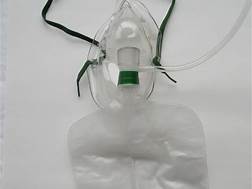A nurse is planning care for a patient who has a tracheostomy and requires oxygen therapy via tracheostomy collar. Which of the following interventions should the nurse include in the plan of care?
Monitor the patient's respiratory rate, depth, rhythm, and effort.
Educate the patient on how to use and care for the tracheostomy collar.
Implement safety measures to prevent fire hazards from the oxygen source.
All of the above.
The Correct Answer is D
Choice A rationale:
Monitoring the patient's respiratory rate, depth, rhythm, and effort is crucial for assessing the effectiveness of oxygen therapy and ensuring proper oxygenation through the tracheostomy collar.
Choice B rationale:
Educating the patient on how to use and care for the tracheostomy collar is essential to ensure the patient's safety and compliance with the therapy.
Choice C rationale:
Implementing safety measures to prevent fire hazards from the oxygen source is crucial, especially when oxygen is delivered via tracheostomy collar, which may have increased oxygen flow rates.
Choice D rationale:
This is the correct choice. All the provided interventions (monitoring respiratory parameters, patient education, and safety measures) are essential components of the plan of care for a patient with a tracheostomy who requires oxygen therapy.
Nursing Test Bank
Naxlex Comprehensive Predictor Exams
Related Questions
Correct Answer is D
Explanation
Choice A rationale:
Monitoring the patient's respiratory rate, depth, rhythm, and effort is crucial for assessing the effectiveness of oxygen therapy and ensuring proper oxygenation through the tracheostomy collar.
Choice B rationale:
Educating the patient on how to use and care for the tracheostomy collar is essential to ensure the patient's safety and compliance with the therapy.
Choice C rationale:
Implementing safety measures to prevent fire hazards from the oxygen source is crucial, especially when oxygen is delivered via tracheostomy collar, which may have increased oxygen flow rates.
Choice D rationale:
This is the correct choice. All the provided interventions (monitoring respiratory parameters, patient education, and safety measures) are essential components of the plan of care for a patient with a tracheostomy who requires oxygen therapy.
Correct Answer is ["A","B","E"]
Explanation

The correct answer is choice a, b, and e.
Choice A rationale:
A non-rebreather mask is designed to deliver a high concentration of oxygen, often deemed the highest among low-flow systems. It achieves this through a reservoir bag that is filled with pure oxygen, which the patient breathes in without the dilution of room air.
Choice B rationale:
This mask has one-way valves that prevent the patient from rebreathing exhaled carbon dioxide. The exhaled air exits through side ports, ensuring that only oxygen from the reservoir is inhaled.
Choice C rationale:
While a non-rebreather mask delivers a high concentration of oxygen, it does not provide a consistent and precise oxygen delivery compared to devices like a Venturi mask, which are designed to deliver a specific and constant oxygen concentration.
Choice D rationale:
The design of a non-rebreather mask does not allow room air to enter through the exhalation ports. The one-way valves are there to ensure that exhaled air does not enter the reservoir bag and that room air does not mix with the oxygen being inhaled.
Choice E rationale:
By delivering a high concentration of oxygen and preventing the rebreathing of exhaled gases, a non-rebreather mask minimizes the risk of carbon dioxide retention, which can be a concern with other oxygen delivery systems that allow for the rebreathing of a portion of exhaled air.
In summary, the non-rebreather mask is advantageous for its ability to deliver a high concentration of oxygen and prevent the rebreathing of exhaled air, which also minimizes the risk of carbon dioxide retention. It is not designed for precise oxygen delivery, nor does it allow the mixing of room air during inhalation.
Whether you are a student looking to ace your exams or a practicing nurse seeking to enhance your expertise , our nursing education contents will empower you with the confidence and competence to make a difference in the lives of patients and become a respected leader in the healthcare field.
Visit Naxlex, invest in your future and unlock endless possibilities with our unparalleled nursing education contents today
Report Wrong Answer on the Current Question
Do you disagree with the answer? If yes, what is your expected answer? Explain.
Kindly be descriptive with the issue you are facing.
